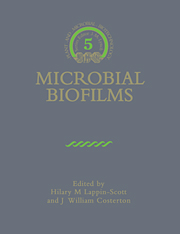Book contents
- Frontmatter
- Contents
- List of Contributors
- Series Preface
- Introduction to Microbial Biofilms
- Part I Structure, Physiology and Ecology of Biofilms
- Part II Biofilms and Inert Surfaces
- 7 Biofilm Development in Purified Water Systems
- 8 Mineralized Bacterial Biofilms in Sulphide Tailings and in Acid Mine Drainage Systems
- 9 Biofilms and Microbially Influenced Corrosion
- 10 Microbial Consortia in Industrial Wastewater Treatment
- 11 Heterogeneous Mosiac Biofilm – A Haven for Waterborne Pathogens
- Part III Biofilms on the Surfaces of Living Cells
- Index
11 - Heterogeneous Mosiac Biofilm – A Haven for Waterborne Pathogens
Published online by Cambridge University Press: 24 November 2009
- Frontmatter
- Contents
- List of Contributors
- Series Preface
- Introduction to Microbial Biofilms
- Part I Structure, Physiology and Ecology of Biofilms
- Part II Biofilms and Inert Surfaces
- 7 Biofilm Development in Purified Water Systems
- 8 Mineralized Bacterial Biofilms in Sulphide Tailings and in Acid Mine Drainage Systems
- 9 Biofilms and Microbially Influenced Corrosion
- 10 Microbial Consortia in Industrial Wastewater Treatment
- 11 Heterogeneous Mosiac Biofilm – A Haven for Waterborne Pathogens
- Part III Biofilms on the Surfaces of Living Cells
- Index
Summary
Waterborne microorganisms
The supply of good quality potable water has been of concern for many years and is of paramount importance for public health. Between 1911 and 1937 there were 20 outbreaks of waterborne disease in the United Kingdom, with 80% of these being due to enteric fever, and the remainder to dysentery and gastroenteritis. The implication that the water supply was the source of a large outbreak of typhoid fever in Croydon, Surrey in 1937, led to the chlorination of public water supplies. This treatment dramatically improved the quality of water supplied to the public and produced improvements in health. Despite chlorination there have been 21 incidents of disease associated with public water supplies since 1937, one of which was due to paratyphoid (George et al. 1972).
The importance of bacterial quality as a measure of water quality has been recognized for many years. Of 495 colonies identified from the water phase, 448 were Gram negative bacteria such as coliforms, Alcaligenes spp. and Pseudomonas spp. (Shannon & Wallace 1944). A diverse range of microorganisms, including Pseudomonas, Flavobacterium, Achromobacter, Klebsiella, Bacillus, Corynebacterium, Mycobacterium, Spirillium, Clostridium, Arthrobacter, Gallionella and Leptothrix spp., is present in potable drinking water (Geldreich et al. 1972), but it is generally considered that these bacteria are not harmful. However, Flavobacterium spp. and Pseudomonas spp. are known opportunistic pathogens, and P. aeruginosa is the major cause of hospital acquired infections (Favero et al. 1971). A total of 15 outbreaks of waterborne disease were identified in the UK between 1977 and 1986 (Galbraith et al. 1987), with Campylobacter enteritis and viral gastroenteritis accounting for 66% of outbreaks.
- Type
- Chapter
- Information
- Microbial Biofilms , pp. 196 - 204Publisher: Cambridge University PressPrint publication year: 1995
- 14
- Cited by



